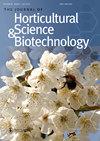百合科三个麝香品种的遗传特性分析
IF 2.1
4区 农林科学
Q2 HORTICULTURE
Journal of Horticultural Science & Biotechnology
Pub Date : 1999-01-01
DOI:10.1080/14620316.1999.11511068
引用次数: 2
摘要
摘要通过对三种麝香草品种的细胞遗传学和同工酶分析,并与麝香草属Leopoldia亚属的野生种进行比较,认为麝香草和麝香草‘Plumosum’显然属于麝香草(L.)种。米勒,第三种,以M. comosum ' Epirus Giant'出售,是一个不同的物种,可能是M. dionysicum Rech。费尔。因此,这个品种出售的巨型性状可能是由于一种物种性状而不是巨型基因型。此外,虽然“plummosum”是一个真正的遗传克隆,但栽培“M. comosum”不是,“Epirus Giant”也不是。最后,我们发现所有的鳞茎都是杂合的,因为该品种的第二对染色体存在反转。我们讨论了这些发现对研究栽培植物相对于其野生祖先的遗传变异的有用性的影响。本文章由计算机程序翻译,如有差异,请以英文原文为准。
Genetic characterization of three cultivars of Muscari comosum (Liliaceae)
SummaryAfter a cytogenetic and isozymatic analysis of three cultivars of Muscari comosum and its comparison with wild species of the subgenus Leopoldia of the genus Muscari, we conclude that while the two cultivars M. comosum and M. comosum `Plumosum' clearly belong to the species M. comosum (L.) Miller, the third, sold as M. comosum `Epirus Giant', is a different species, possibly M. dionysicum Rech. fil. Therefore, the giant character on which this cultivar is sold is due possibly to a species trait rather than a giant genotype. Furthermore, while M. comosum `Plumosum' is a true genetic clone, the cultivar M. comosum is not, nor is `Epirus Giant'. Finally, we show that all the bulbs of the cultivar M. comosum are heterozygous for the inversion present in the second chromosome pair of this species. We discuss the implications of these findings in relation to the usefulness of studying the genetic variability of cultivated plants with respect of their wild ancestors.
求助全文
通过发布文献求助,成功后即可免费获取论文全文。
去求助
来源期刊
CiteScore
3.90
自引率
5.30%
发文量
67
审稿时长
3 months
期刊介绍:
The Journal of Horticultural Science and Biotechnology is an international, peer-reviewed journal, which publishes original research contributions into the production, improvement and utilisation of horticultural crops. It aims to provide scientific knowledge of interest to those engaged in scientific research and the practice of horticulture. The scope of the journal includes studies on fruit and other perennial crops, vegetables and ornamentals grown in temperate or tropical regions and their use in commercial, amenity or urban horticulture. Papers, including reviews, that give new insights into plant and crop growth, yield, quality and response to the environment, are welcome, including those arising from technological innovation and developments in crop genome sequencing and other biotechnological advances.

 求助内容:
求助内容: 应助结果提醒方式:
应助结果提醒方式:


